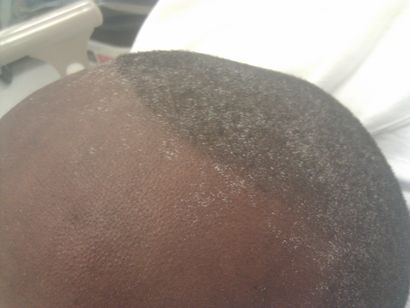يوريميا
| اليوريميا Uremia | |
|---|---|
| الأسماء الأخرى | Uraemia |
 | |
| صقيع يوريمي يظهر على جبهة وفروة رأس شاب يشكو من anorexia and fatigue with blood urea nitrogen and serum creatinine levels of approximately 100 and 50 mg/dL respectively. | |
| التخصص | طب الكلى |
اليوريميا أو التبولن [1] أو التسمم البوليني Uremia، هي حالة تسمم الدم بنسبة مرتفعة من اليوريا نتيجة فشل الكلى في افرازها بالبول. أهم فضلات التمثيل الغذائي للبروتين في الإنسان والثدييات والأسماك ولكن ليس في الطيور ولا الزواحف التي تخرج عوضا عنها الحمض البولي، تقوم الكبد بإفراز البولينا، وتقوم الكليتان بإخراحها من الجسم وللبولينا من الخواص الطبيعية والكيميائية ما يجعلها أفضل مادة للتخلص من أزوت الأحماض الأمنية التي لا تستعمل في بناء البروتوبلازم فالبولينا مادة عضوية تحوي نسبة كبيرة من الأزوت، سهلة الذوبان في الماء وتمر بسهولة من أغشية الخلايا بحيث توجد بنفس النسبة تقريبا في الدم والأنسجة وسوائلها ومحلولات البولينا متعادلة فلا يؤثر تكوينها في درجة تفاعل الدم، وفي أمراض الكبد لا تتتأثر البولينا إلا فيما قبل والوفاة إذ أن 10 % من نسيج الكبد يكفي في أمراض الكلية فلا ترتفع نسبتها في الدم إلا في الحالات الشديدة جدا التي تكاد تقف فيها وظيفة الكليتين.
. . . . . . . . . . . . . . . . . . . . . . . . . . . . . . . . . . . . . . . . . . . . . . . . . . . . . . . . . . . . . . . . . . . . . . . . . . . . . . . . . . . . . . . . . . . . . . . . . . . . . . . . . . . . . . . . . . . . . . . . . . . . . . . . . . . . . . . . . . . . . . . . . . . . . . . . . . . . . . . . . . . . . . . .
الأعراض والعلامات
من الأعراض التقليدية لليوريميا الضعف التدريجي والإرهاق البسيط، فقدان الشهية بسبب الغثيان والقيء، ضمور العضلات، الرعشة، اضطراب الوظائف العقلية، ضيق التنفس المتكرر، والحماض الأيضي. إذا ما ترك المرض دون علاج، مثل غسيل أو زراعة الكلى، فسوف يؤدي إلى حدوث فشل كلوي، غيبوبة، ووفاة.[2] Because uremia is mostly a consequence of kidney failure, its signs and symptoms often occur concomitantly with other signs and symptoms of kidney failure. Below is a table showing more of the principal signs and symptoms of uremia.
الأسباب
التشخيص
تحاليل الدم
تحاليل البول
اختبارات النظائر المشعة
أخرى
الآلية
| Solute Group | مثال | المصدر[1] | الخصائص |
|---|---|---|---|
| peptides and small proteins | β2-microglobulin | shed from major histocompatibility complex | poorly dialyzed because of large size |
| guanidines | guanidinosuccinic acid | arginine | increased production in uremia |
| phenols | ρ-cresol sulfate | phenylalanine, tyrosine | protein bound, produced by gut bacteria |
| indoles | indican | tryptophan | protein bound, produced by gut bacteria |
| aliphatic amines | dimethylamine | choline | large volume of distribution, produced by gut bacteria |
| polyols | CMPF | unknown | tightly protein bound |
| ucleosides | pseudouridine | tRNA | most prominent of several altered RNA species |
| dicarboxylic acids | oxalate | ascorbic acid | formation of crystal deposits |
| carbonyls | glyoxal | glycolytic intermediates | reaction with proteins to form advanced glycation end-products |
- ^1 There may be multiple sources. Only one is listed. CMPF=3-carboxyl-4-methyl-5-propyl-2-furanpropionic acid
| السم | المصدر |
|---|---|
| Urea | At high concentrations [>300 mg/dL(>50 mmol/L)]: headaches, vomiting, fatigue, carbamylation of proteins |
| Creatinine | Possibly affects glucose tolerance and erythrocyte survival |
| Cyanate | Drowsiness and hyperglycemia, carbamylation of proteins and altered protein function due to being a breakdown product of urea |
| Polyols (e.g., myoinositol) | Peripheral neuropathy |
| Phenols | Can be highly toxic as they are lipid-soluble and therefore can cross cell membranes easily |
| "Middle molecules"[2] | Peritoneal dialysis patients clear middle molecules more efficiently than hemodialysis patients. They show fewer signs of neuropathy than hemodialysis patients |
| β2-Microglobulin | Renal amyloid |
الخصائص البيوكيميائية
| Retained Nitrogenous Metabolites | Fluid, Acid-Base, and Electrolyte Disturbances | Carbohydrate Intolerance | Anormal Lipid Metabolism | Altered Endocrine Function |
|---|---|---|---|---|
| Urea | Fixed urine osmolality | Insulin resistance (hypoglycemia may also occur) | Hypertriglyceridemia | Secondary hyperparathyroidism |
| Cyanate | Metabolic acidosis | Plasma insulin normal or increased | Decreased high-density lipoprotein cholesterol | Altered thyroxine metabolism |
| Creatinine | Hyponatremia or hypernatremia or hypercalcemia | Delayed response to carbohydrate loading | Hyperlipoproteinemia | Hyperreninemia and hyperaldosteronism |
| Guanidine Compounds | Hyperchloremia | Hyperglucagonemia | Hyporeninemia | |
| "Middle molecules"[3] | Hypocalcemia | Hypoaldosteronism | ||
| Uric acid | Hyperphosphatemia | Decreased erythropoietin production | ||
| Hypermagnesemia | Gonadal dysfunction (increased prolactin and luteinizing hormone, decreased testosterone) | |||
| Decreased sodium-potassium ATPase activity | Increased serum gastrin and melanocyte-stimulating hormone |
- ^1 Atrial natriuretic peptide, Cystatin C, Delta sleep-inducing peptide, Interleukin-6, Tumor necrosis factor alpha, Parathyroid hormone
التاريخ
المصادر
- ^ قاموس المورد، البعلبكي، بيروت، لبنان.
- ^ أ ب ت خطأ استشهاد: وسم
<ref>غير صحيح؛ لا نص تم توفيره للمراجع المسماةtietz - ^ أ ب ت خطأ استشهاد: وسم
<ref>غير صحيح؛ لا نص تم توفيره للمراجع المسماةmeyer - ^ خطأ استشهاد: وسم
<ref>غير صحيح؛ لا نص تم توفيره للمراجع المسماةalmeras - ^ أ ب خطأ استشهاد: وسم
<ref>غير صحيح؛ لا نص تم توفيره للمراجع المسماةdepner
وصلات خارجية
| Classification | |
|---|---|
| External resources |
- Uremia, Medscape.
- Uremia, WebMD.com
- Understanding Uremia, uspharmacist.com

